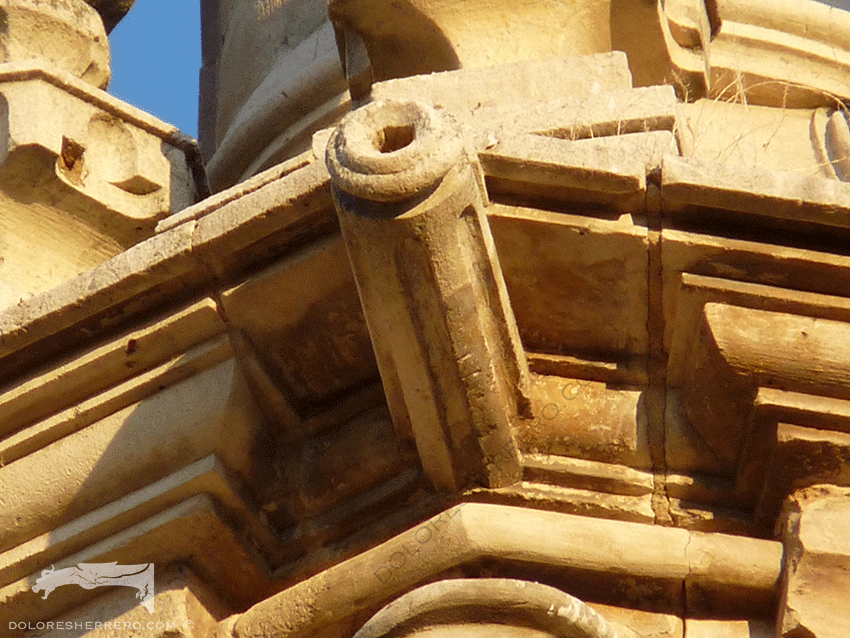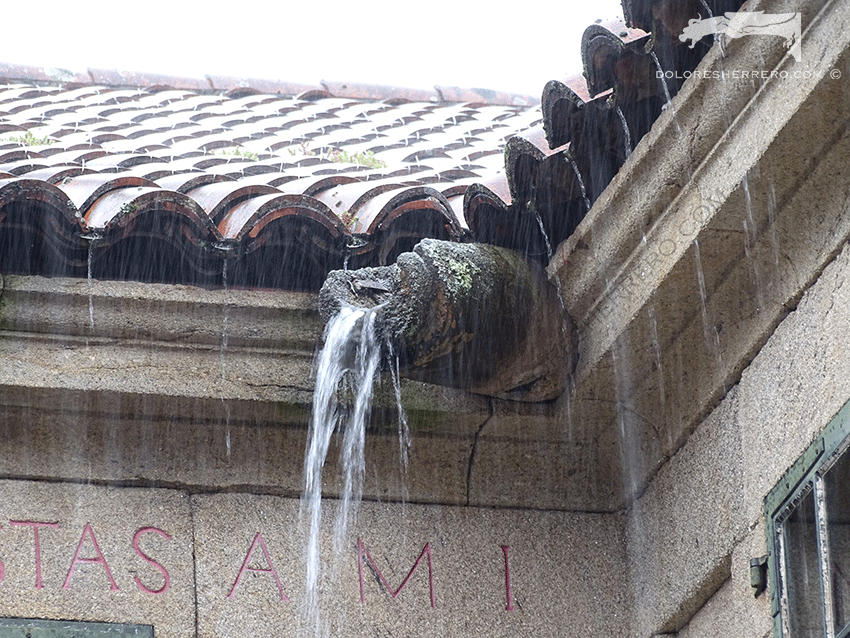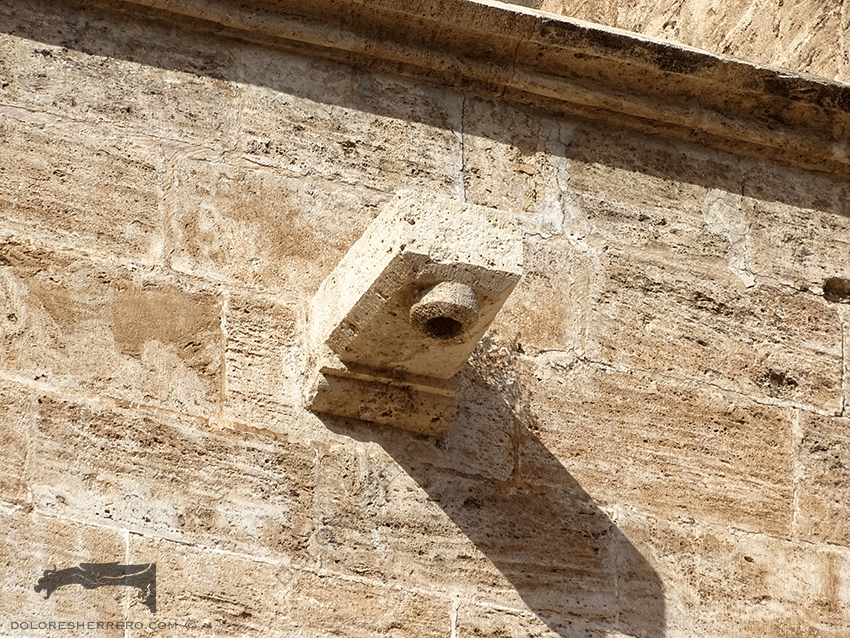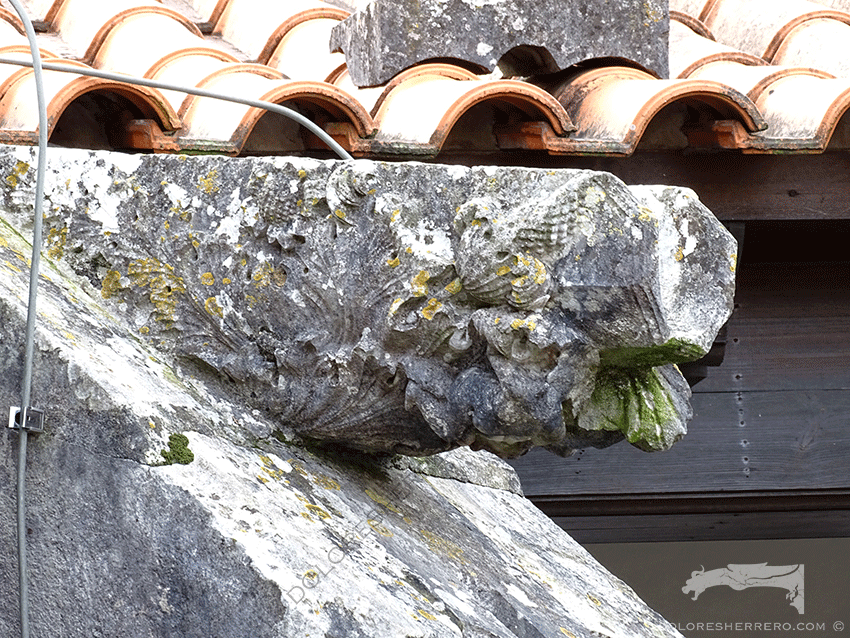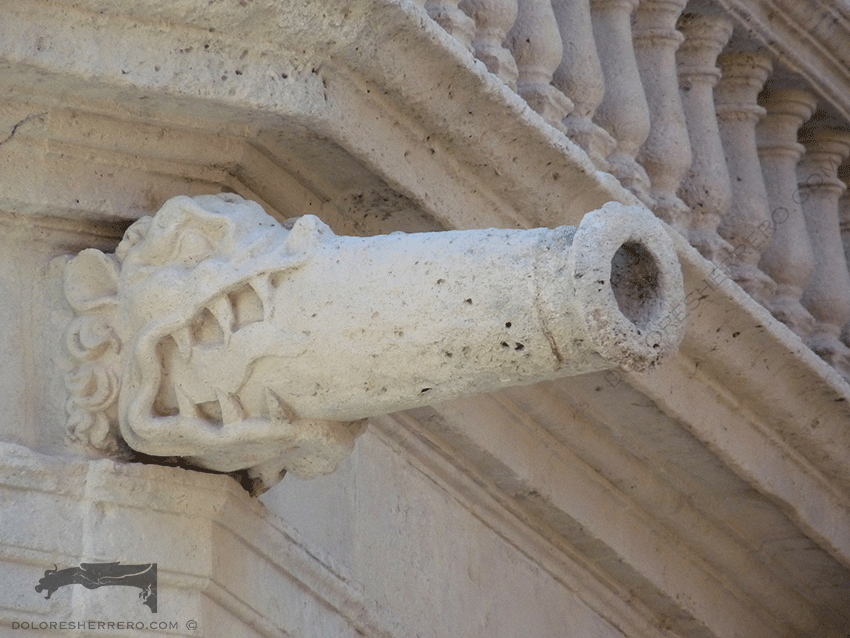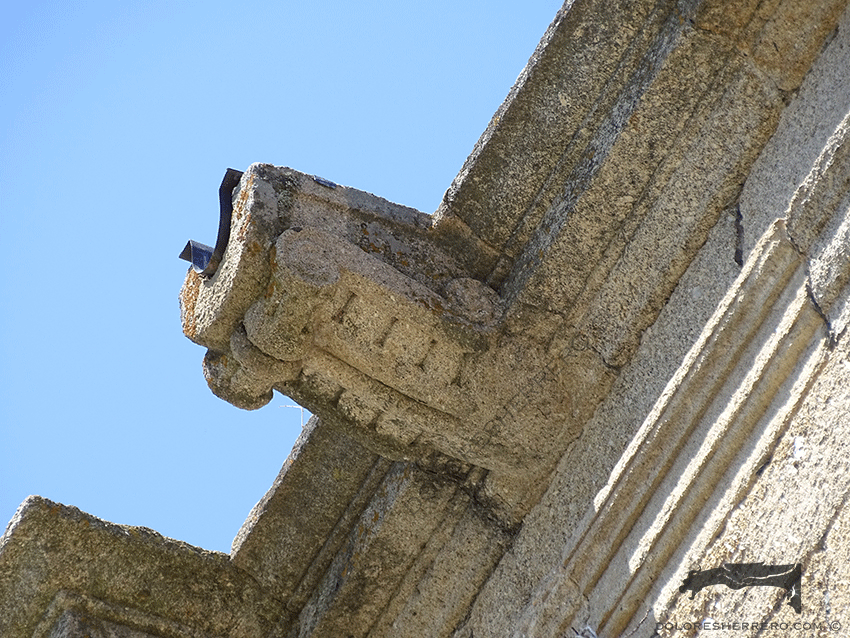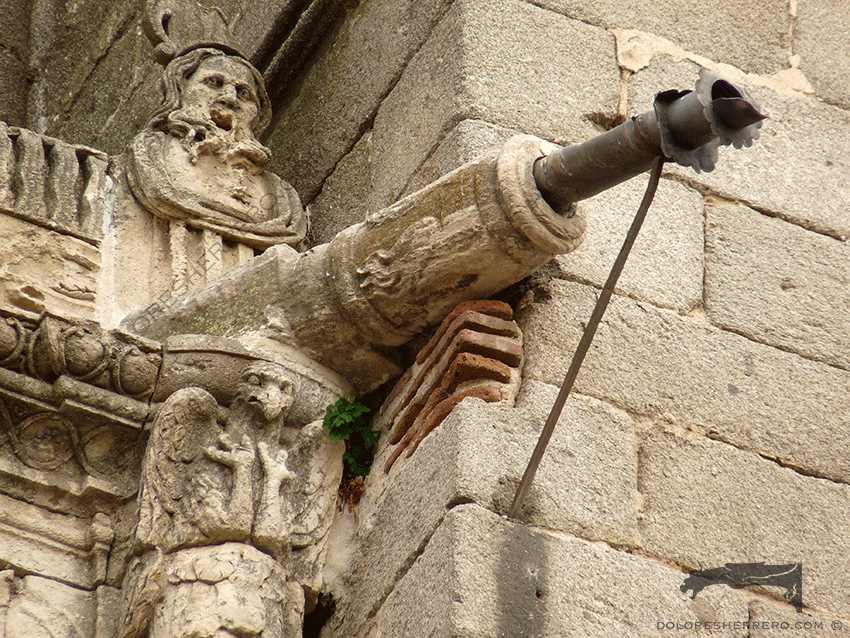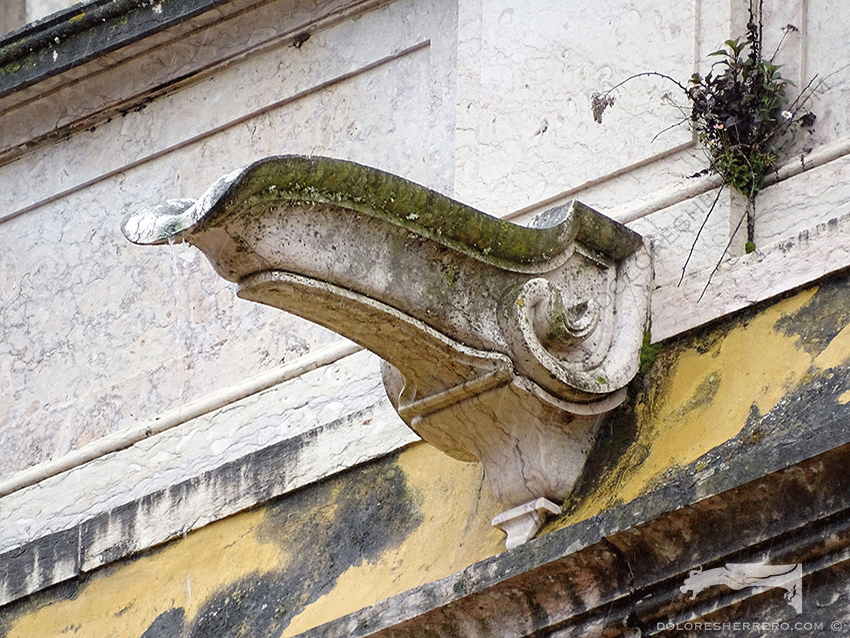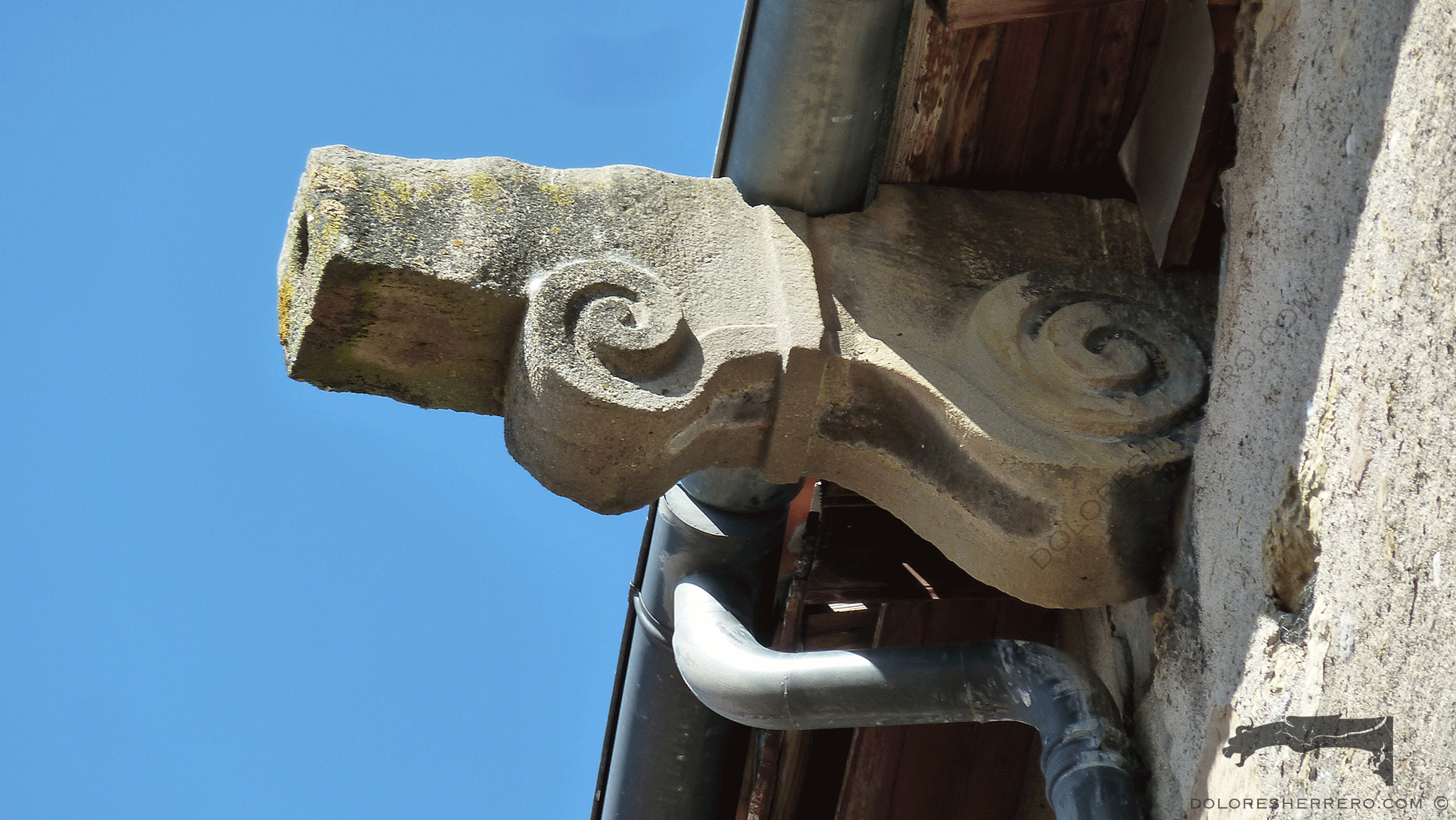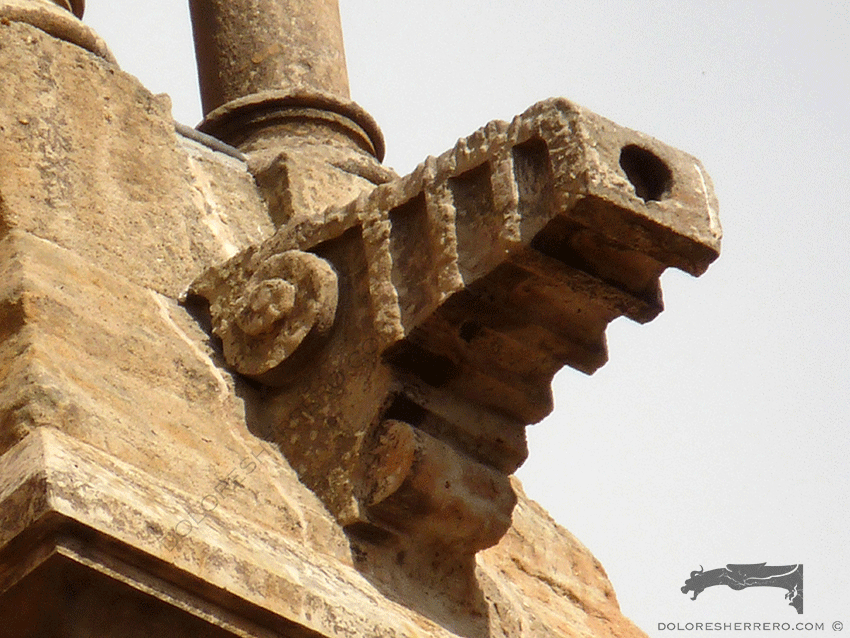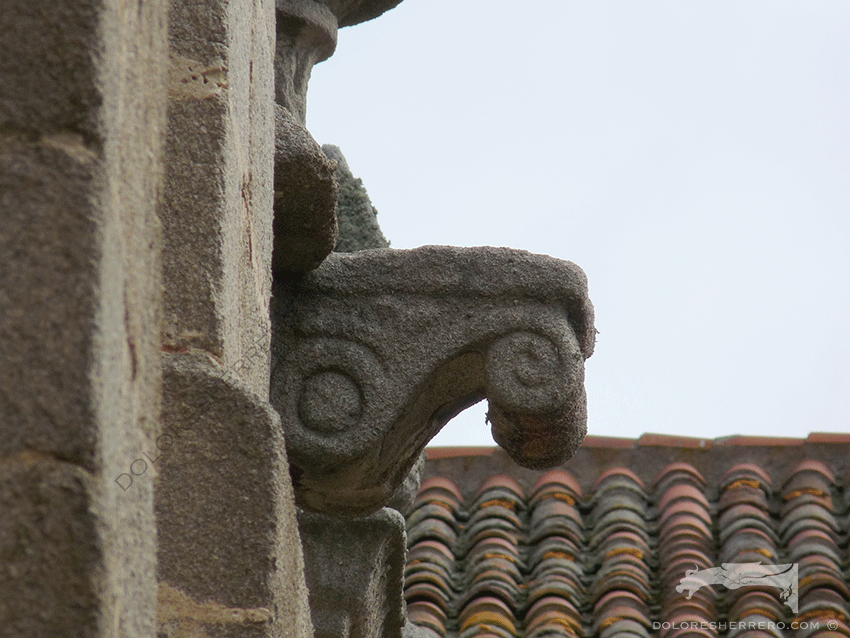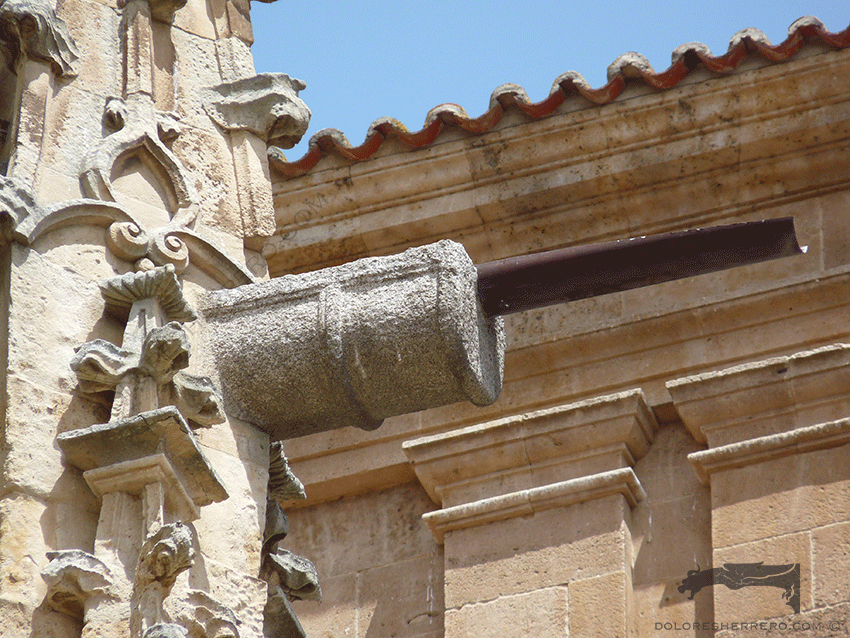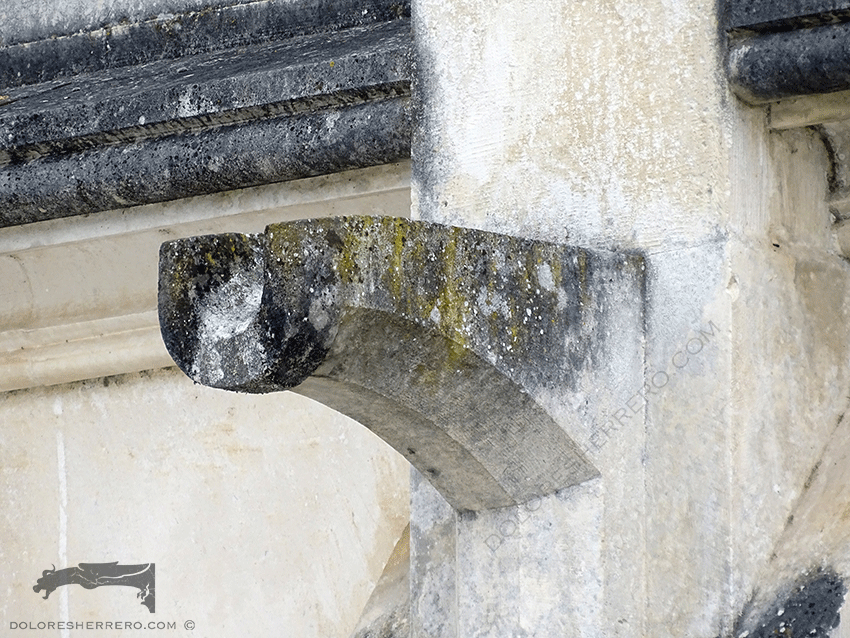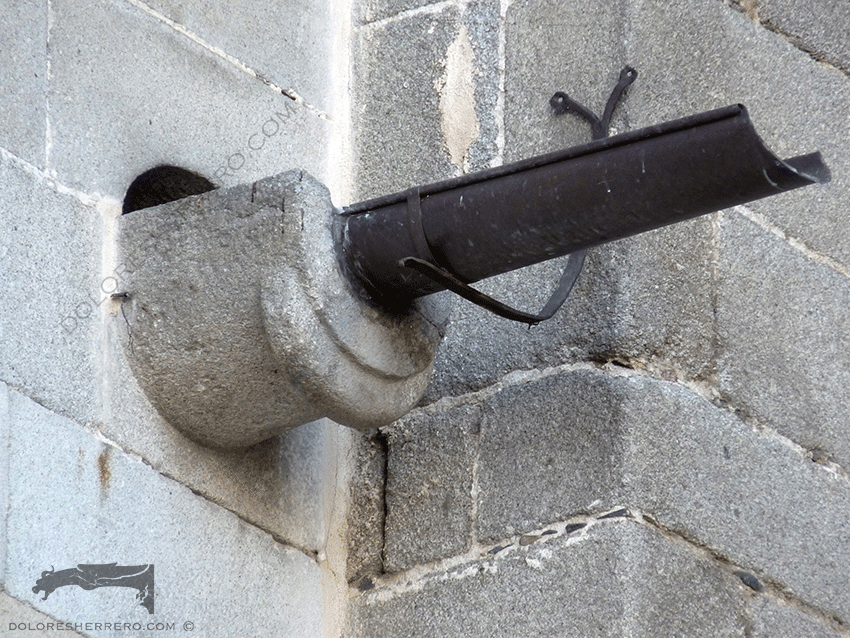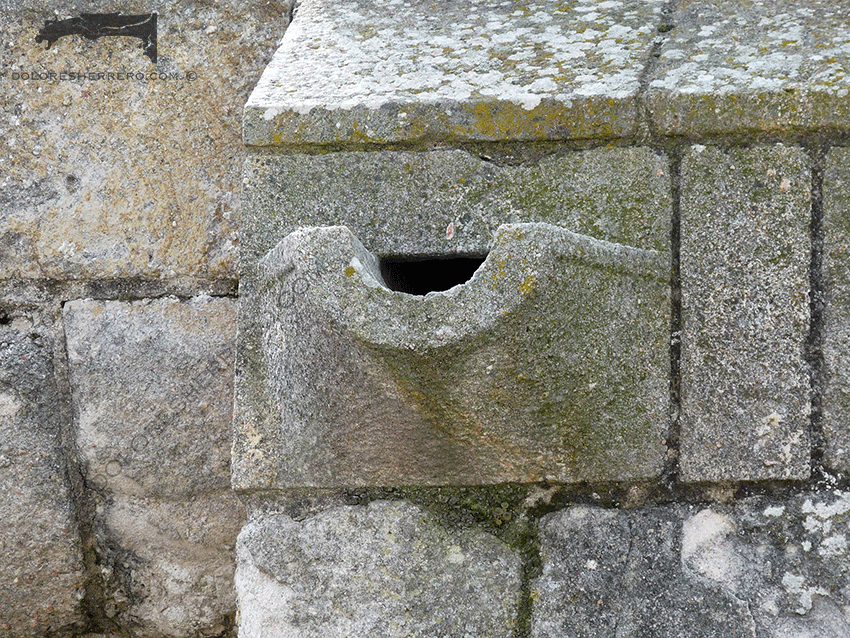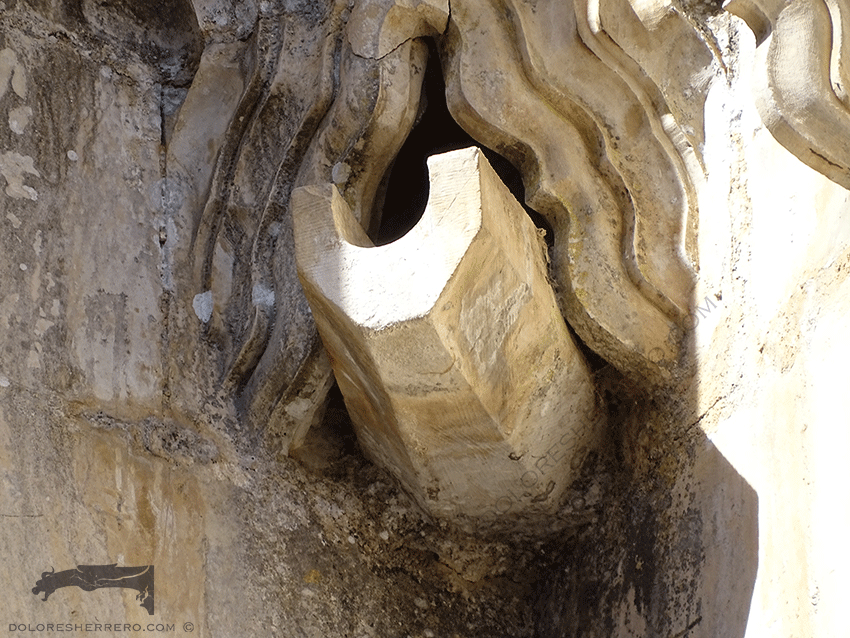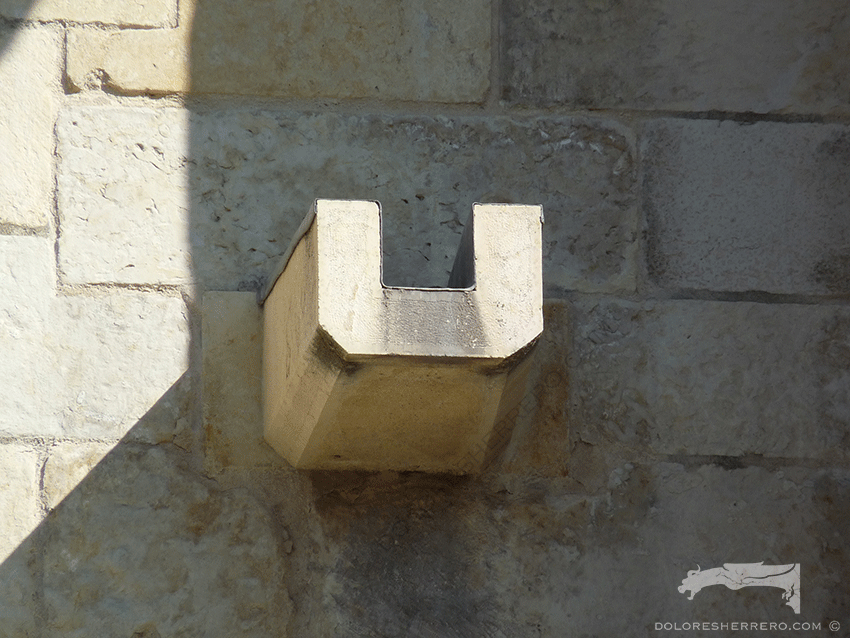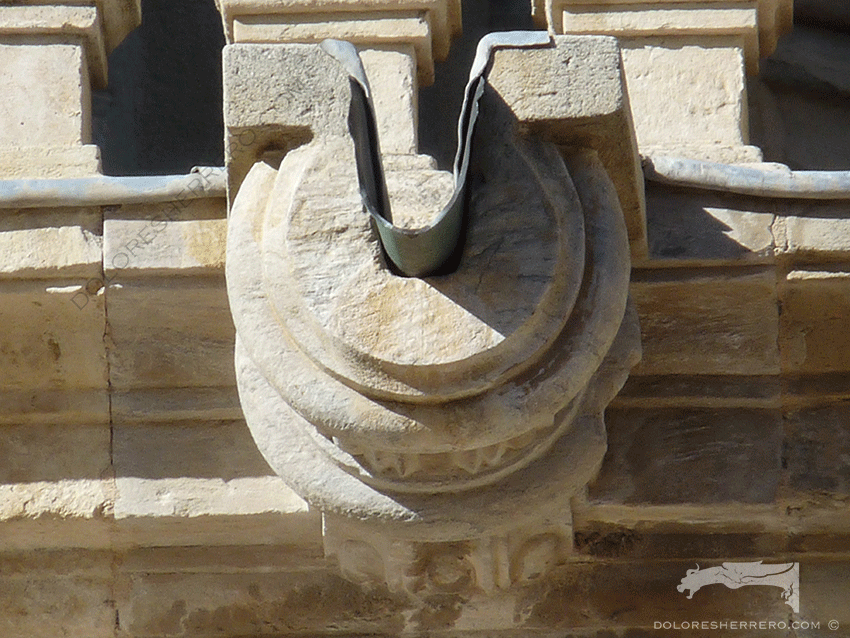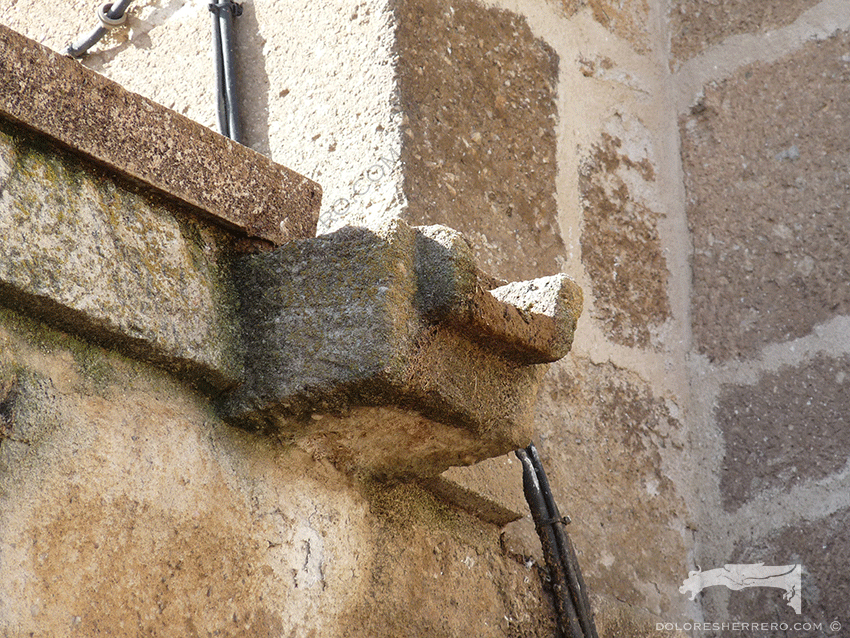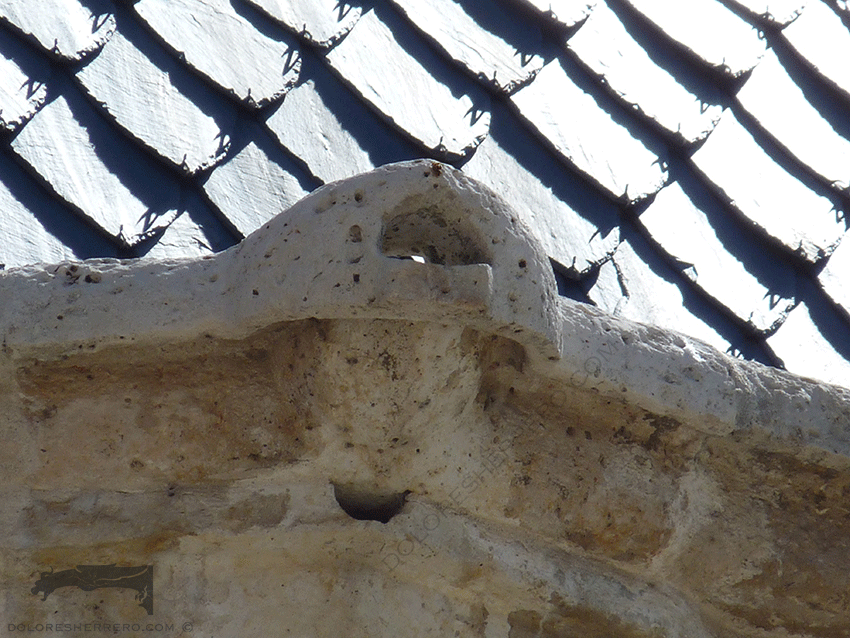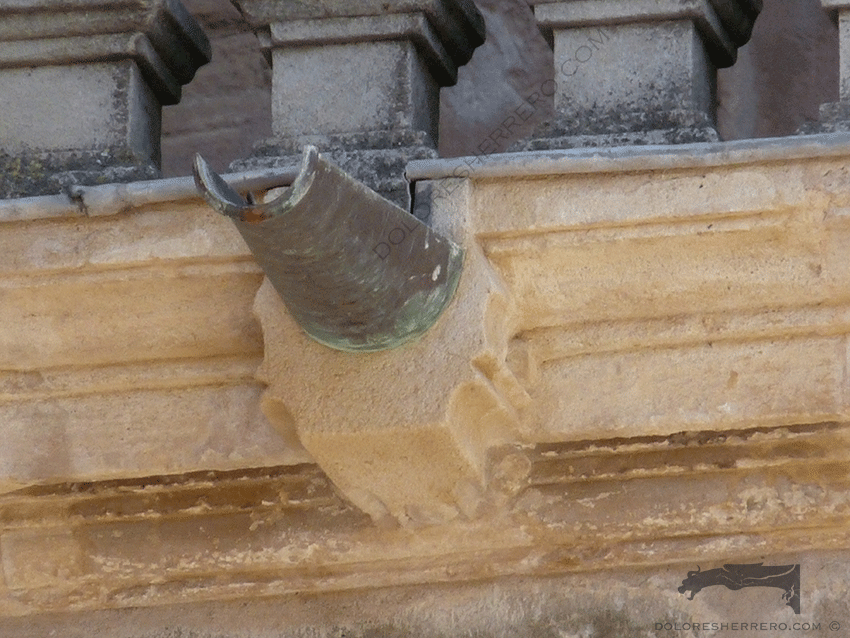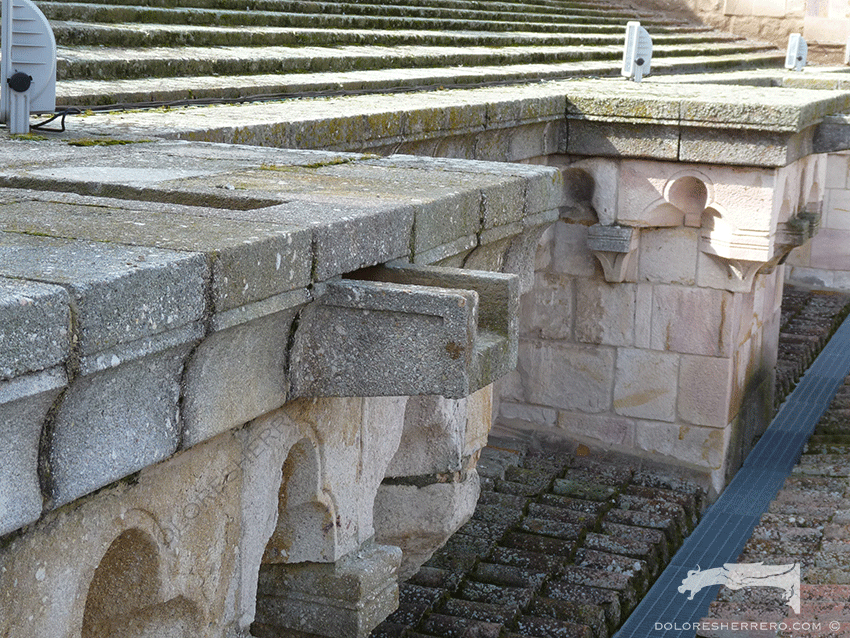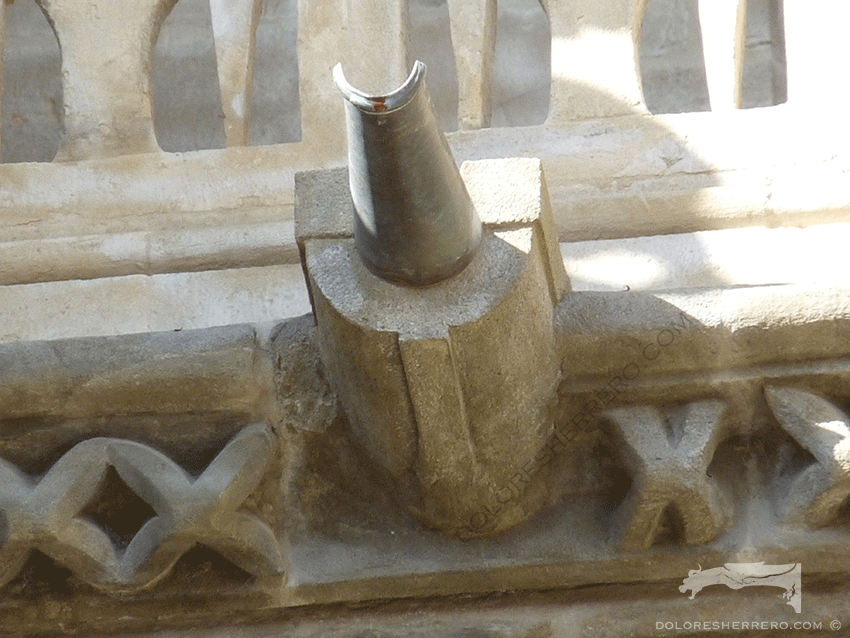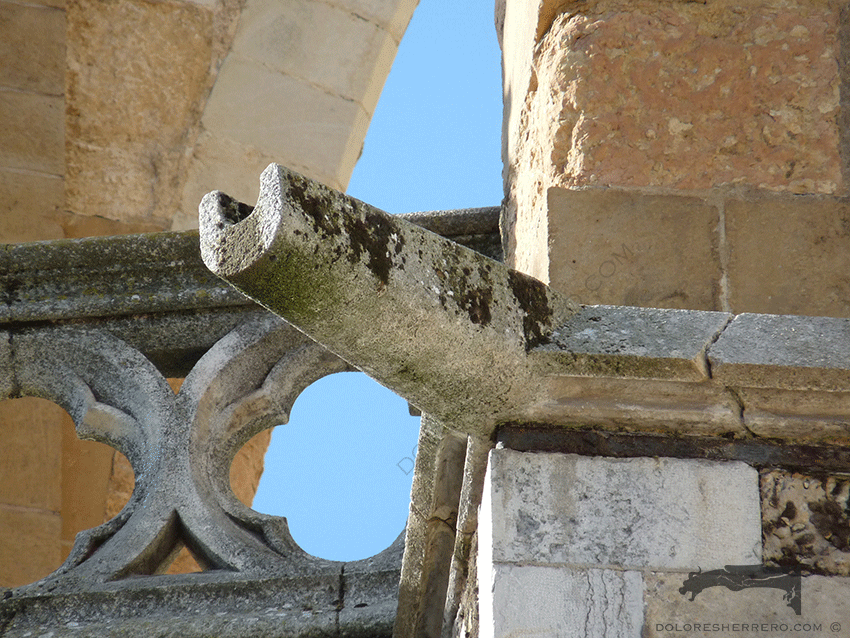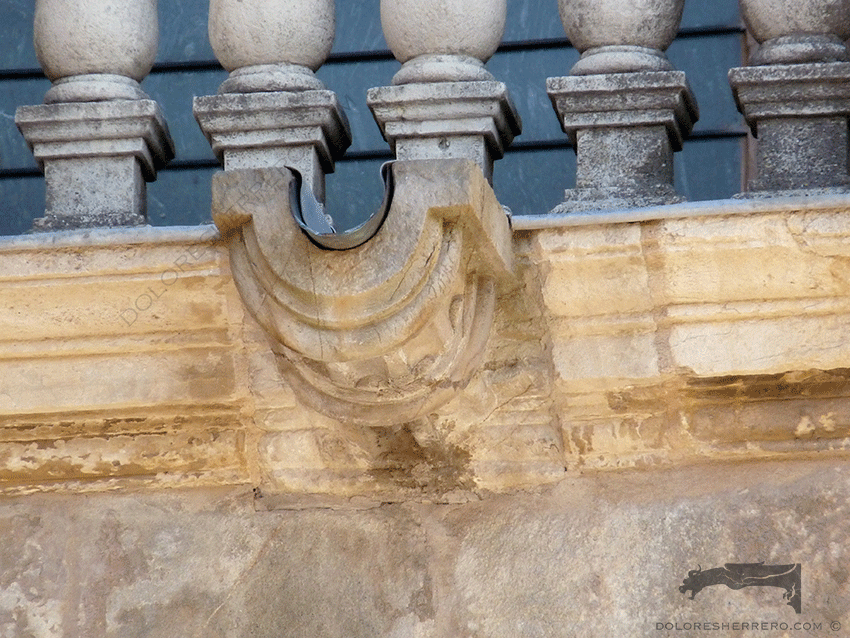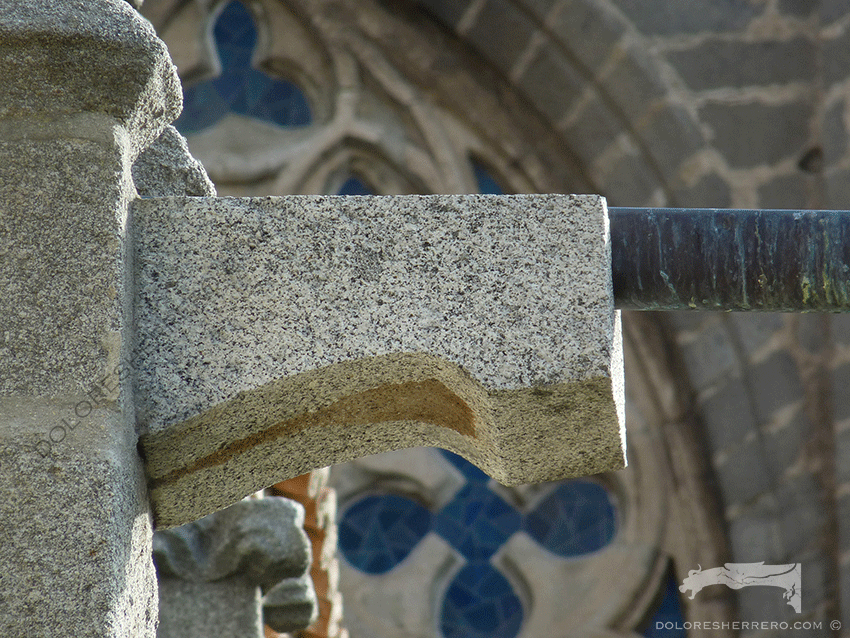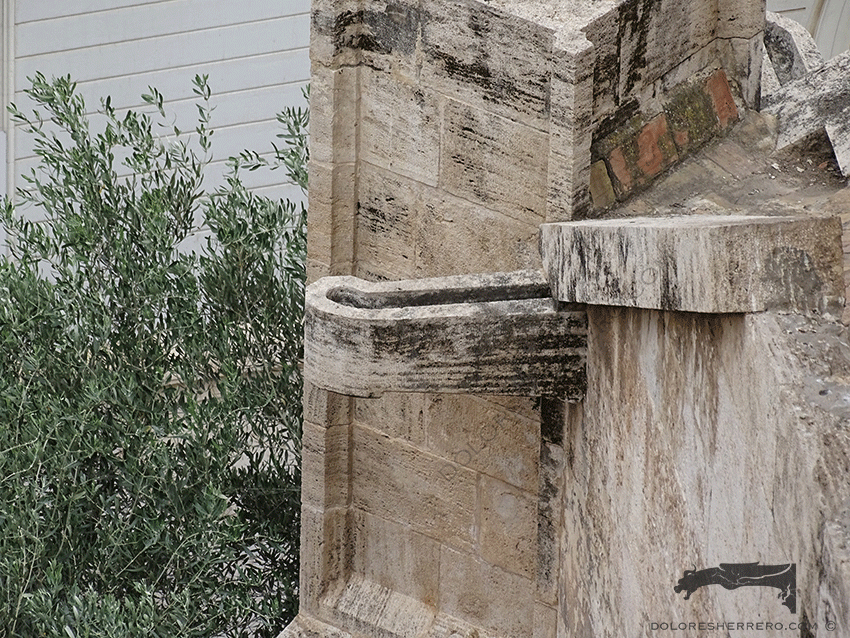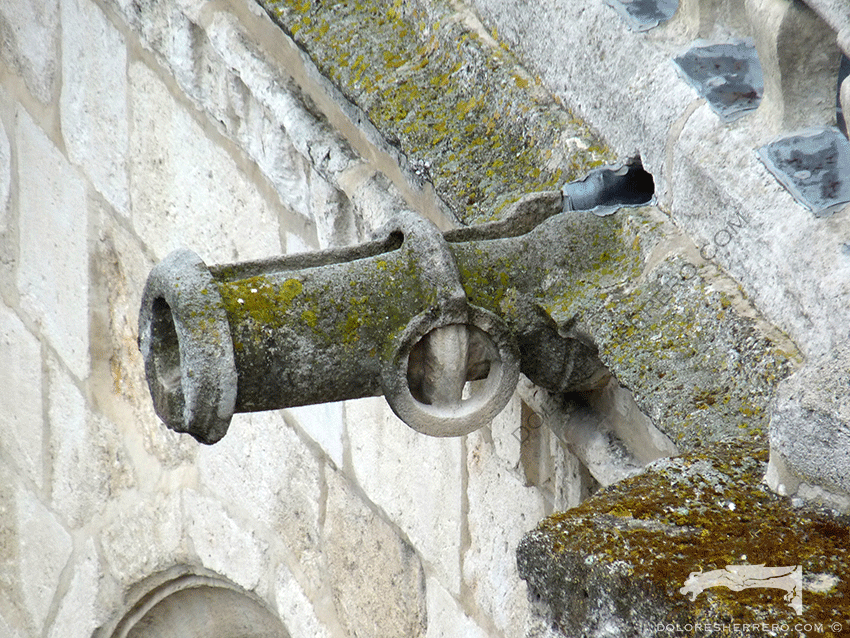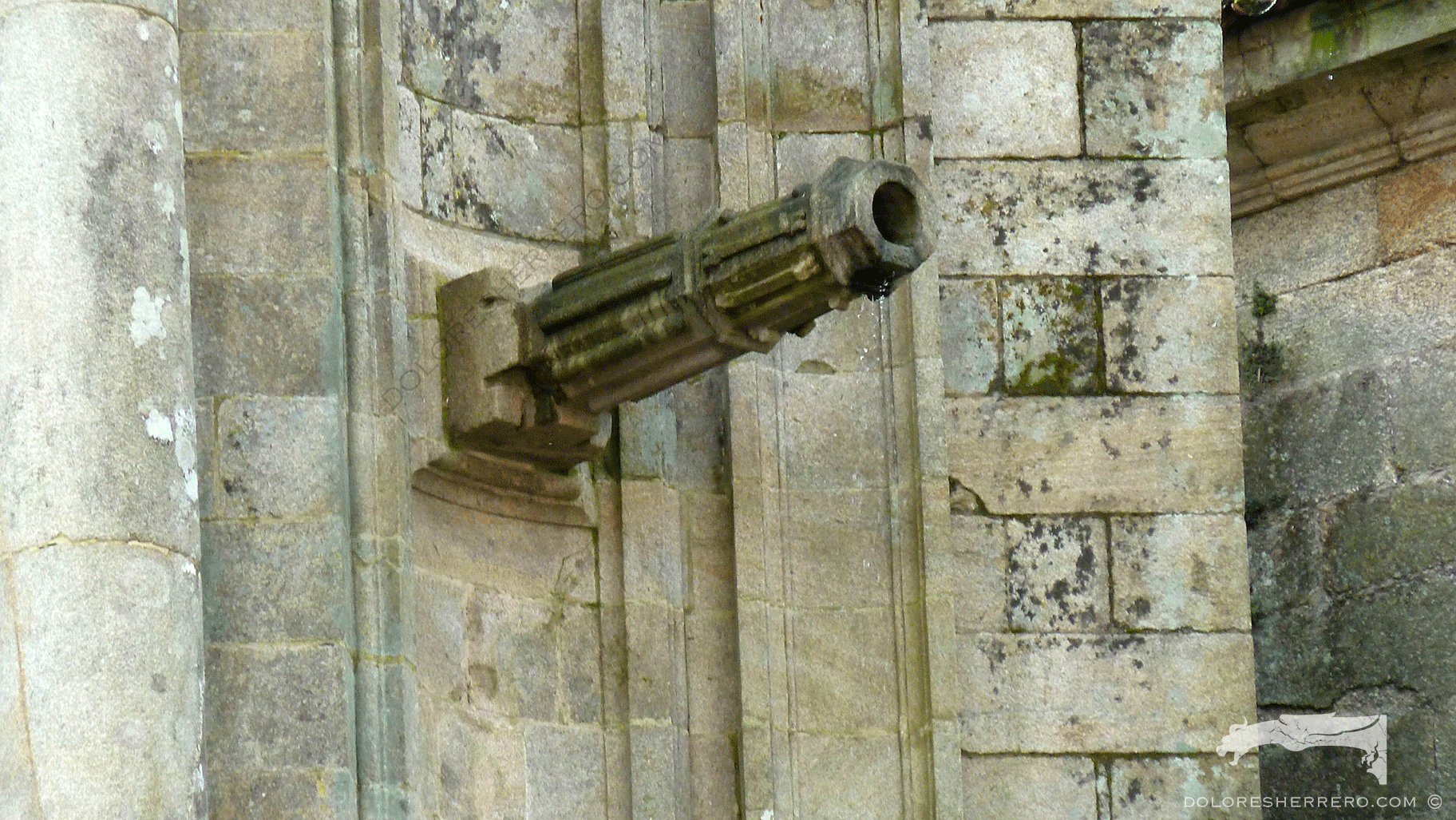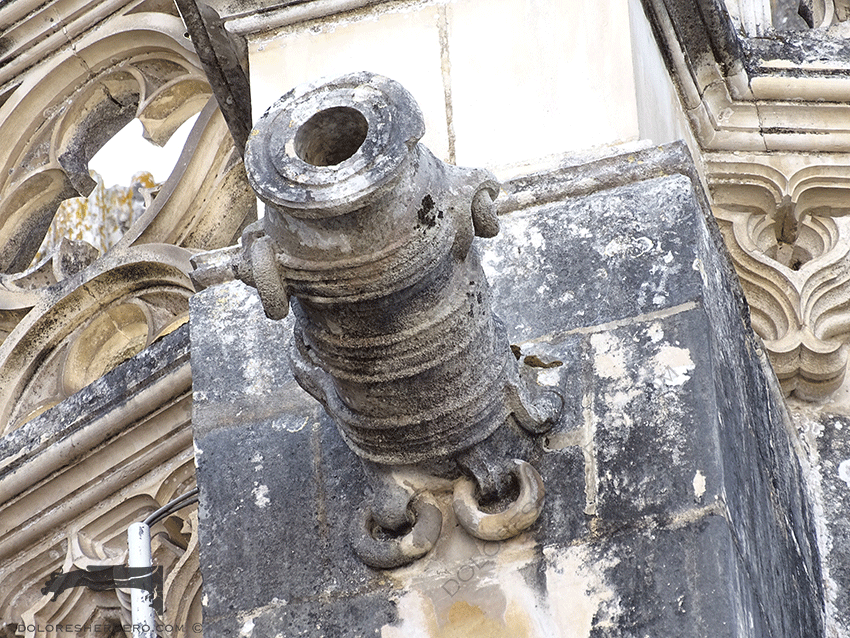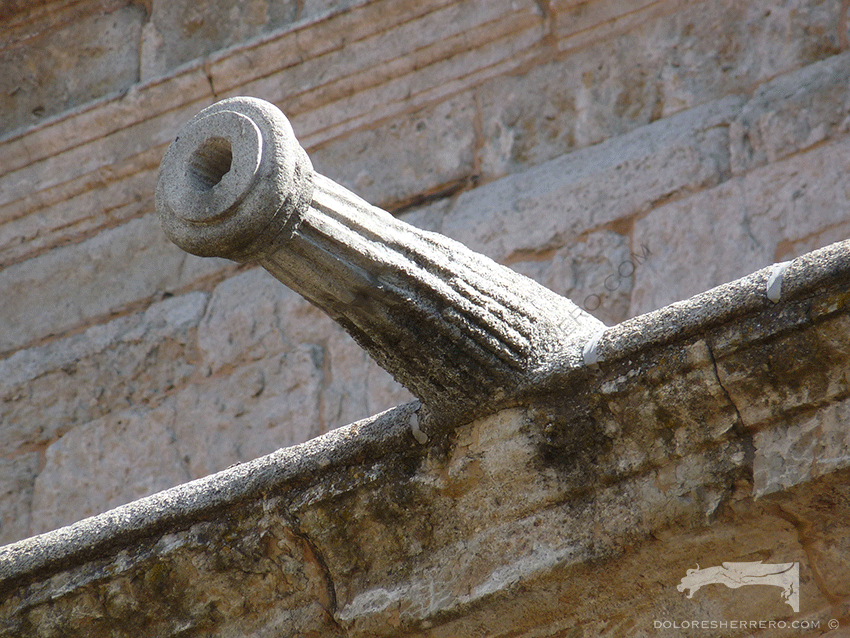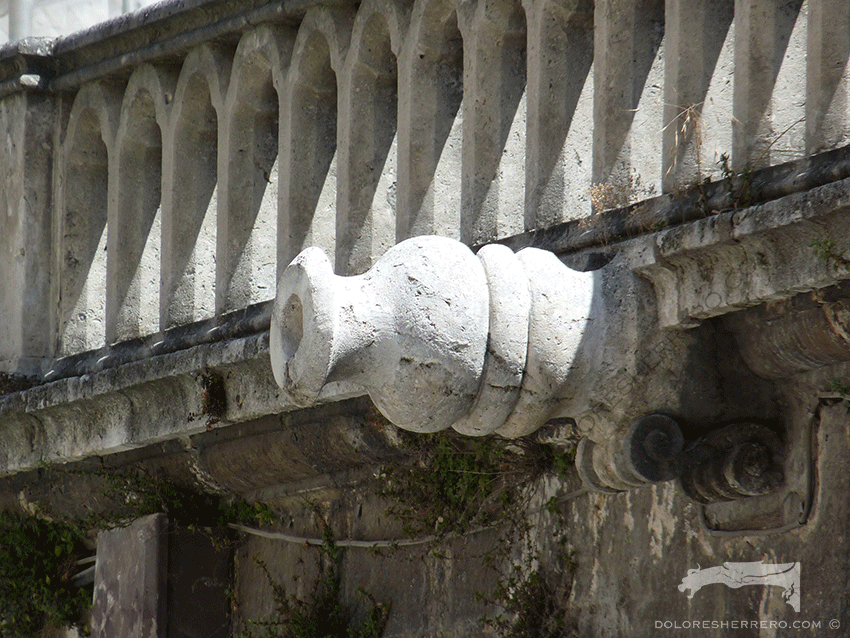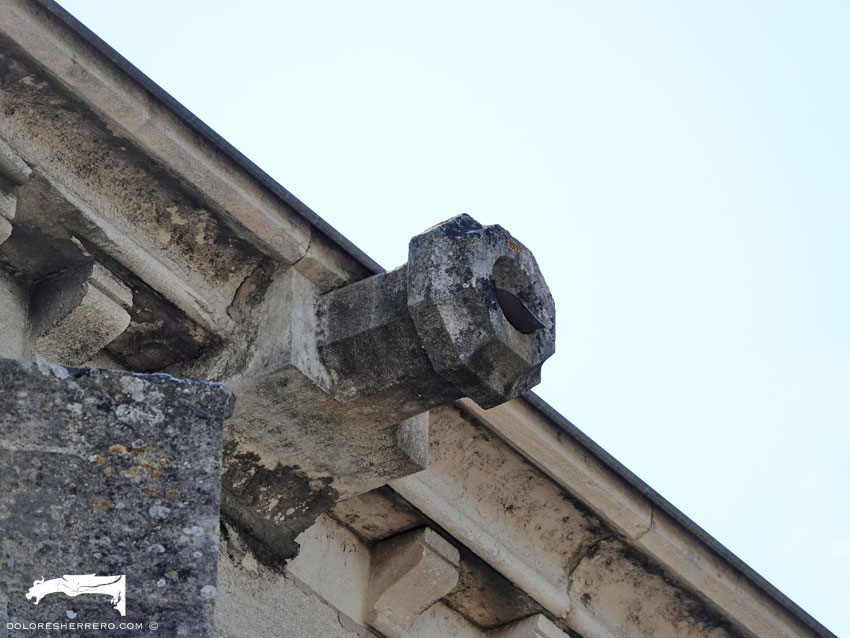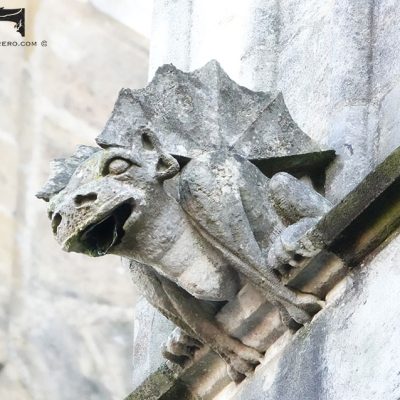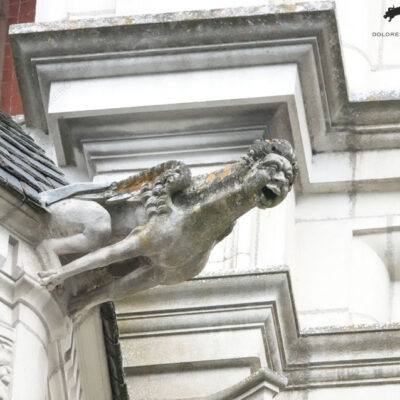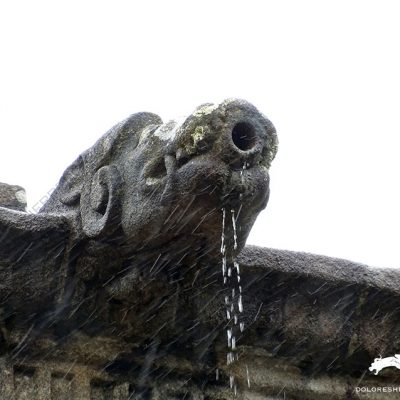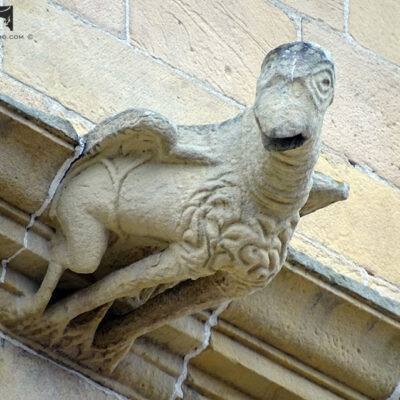We probably all love mediaeval gargoyles depictting realistic, fantastic, monstrous or terrifying creatures. However, we shouldn’t dismiss geometric gargoyles; although most of them are contemporary, they too are often interesting in form and style.
Today, we’ll be talking about geometric gargoyles and those representing a variety of objects, because these also demonstrate their sculptor’s creativity.
- Astorga Cathedral (Spain)
- Former Hospital of San Roque (Santiago de Compostela, Spain)
- Valencia Cathedral (Spain)
Geometric Forms in Gargoyle Iconography: A Language of Symmetry and Symbolism
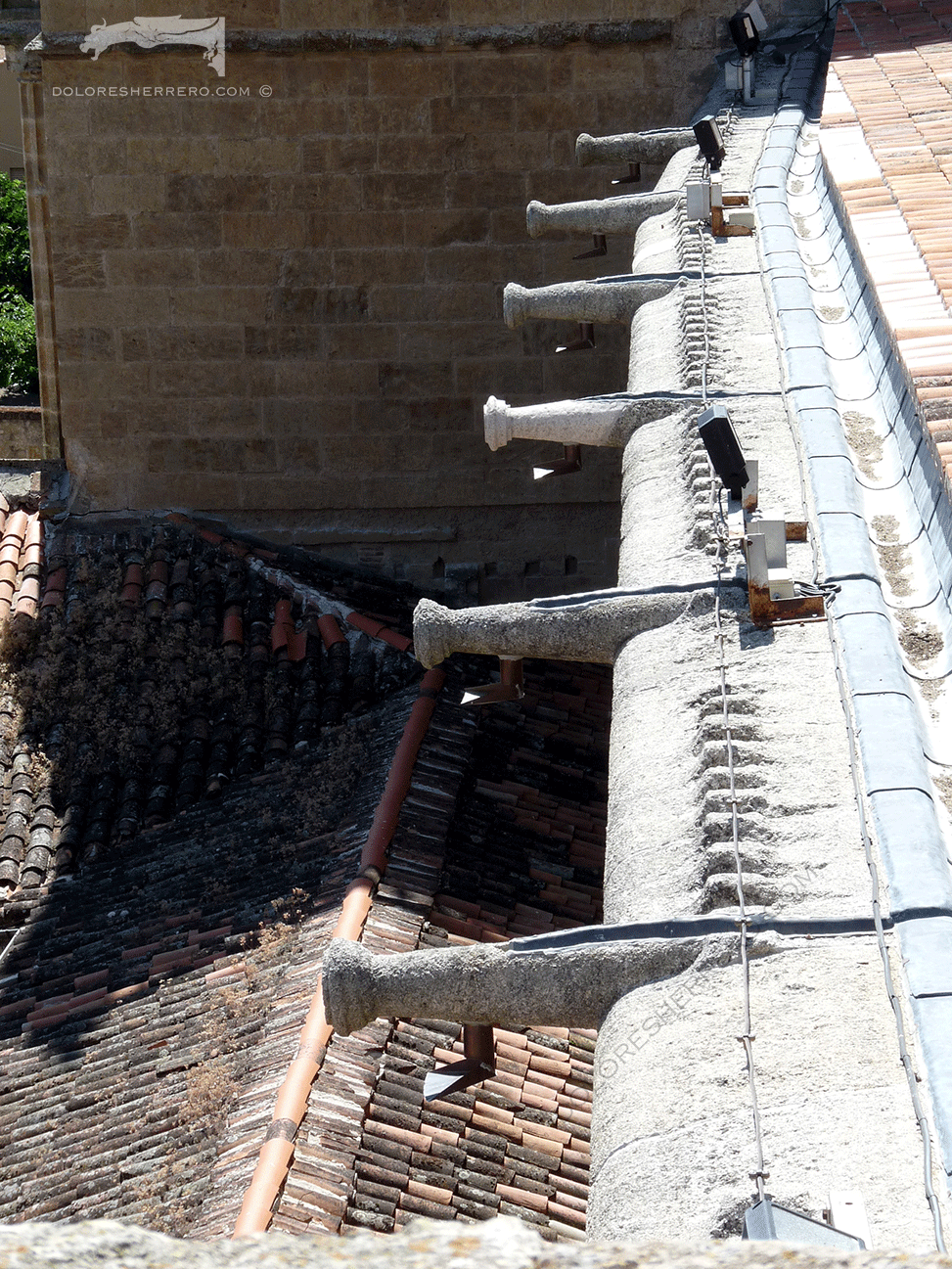
Ciudad Rodrigo Cathedral (Spain)
After the Gothic period, the use of gargoyles to depict humans and beings of all kinds declined in favour of simple metal or stone spouts, although gargoyles representing creatures continued to be produced in the Renaissance, especially in Spain.
But by the mid-16th century, cylindrical gargoyles with geometric designs predominated.
Geometrical gargoyles can be rectangular, cylindrical, quadrangular or polygonal in shape, and the most common geometric designs used to decorate them are circles and spirals, although leaves of all kinds continued to be used, many of the acanthus type. Occasionally, they also depict figures of animals, humans or monsters, and sinuous or undulating lines in unique and creative designs of the artist’s own invention. Some geometric gargoyles are of astounding artistic beauty, sculpted with exuberant decoration and magnificent carving.
- Batalha Monastery (Portugal)
- Burgos Cathedral (Spain)
- Coria Cathedral (Cáceres, Spain)
These geometric elements have a symbolic meaning that dates back to antiquity and has survived as an ornamental motif to the present day in all the arts.
Some gargoyles are decorated with undulating serpentine lines, which the 18th century British artist, William Hogarth, called the “line of beauty”: “The serpentine line, by its waving and winding at the same time different ways, leads the eye in a pleasing manner along with the continuity of its variety, if I may use this expression; and, by its twisting in so many different ways, it may be said to include (even if it is only one line) diverse content”.
- Ávila Cathedral (Spain)
- National Palace of Mafra (Portugal)
- Temple of Heaven (Beijing, China)
Circles and spirals were the most common elements used to decorate geometric gargoyles. The circle is probably the most important and frequently represented geometric symbol. Significantly, both the moon and the sun bear this shape, hence its importance since antiquity. The circle universally symbolises the celestial sphere and the heavens, while the square symbolises the Earth and humanity. God is sometimes depicted as a circle with an omnipresent centre to signify perfection. The circle has no beginning or end, no direction or orientation; thus, it also symbolises all that is spiritual. The Platonic and Neoplatonic philosophers considered the circle the most perfect form, and Plato uses a sphere to represent the psyche. Circular motion is perfect and immutable: consequently, it is also used to symbolise time, which is defined as a continuous, invariable succession of identical moments. Since ancient times, the circle has been used to indicate totality and perfection, and to encompass time and to measure it better. The circle has been used in conjunction with the square to represent heaven and earth since as far back as the Babylonians. Jung reveals that the symbol of the circle is an archetypal image of the totality of the psyche, the symbol of the self; while the square is the symbol of earthly matter, the body and reality.
In some works of art, the circle is used symbolically, as in depictions of the disciples surrounding Christ, or of heaven as concentric choirs of angels. In Christian iconography, it symbolises eternity; three circles joined together evoke the Trinity of the Father, the Son and the Holy Ghost. Following the principles proposed by Alberti (1404-1472), Renaissance architects returned to the circle when designing churches.
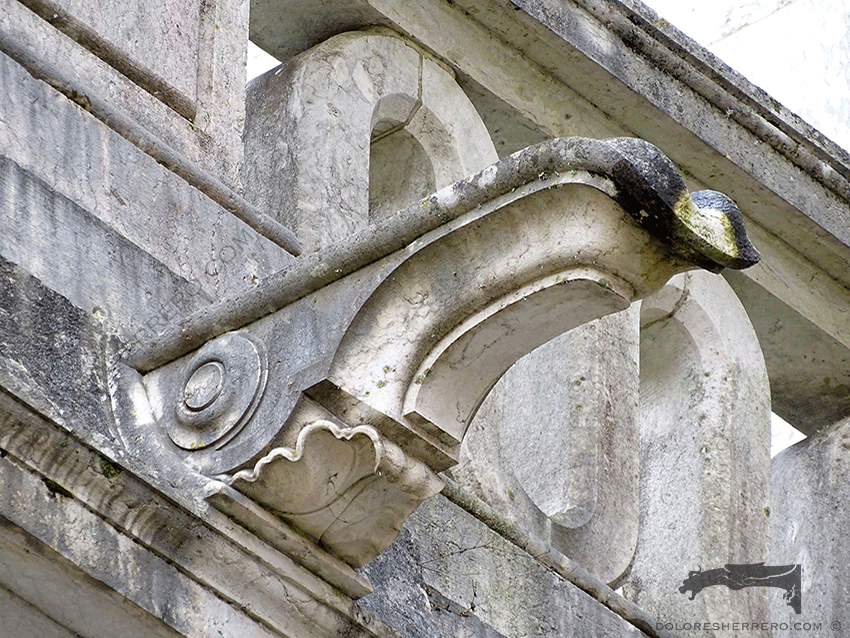
National Palace of Mafra (Portugal)
The spiral has also been used as a symbol since ancient times. It is a simple figure, a line that wraps around itself, but is also dynamic, moving inwards or outwards, depending on how you look at it. The origin of its worldwide use as a symbol might be related to the observation of turbulence in flowing water, or to the eddies that occur when water rushes downstream through an opening. The spiral appears in some prehistoric megalithic funerary constructions, perhaps linked to the idea of falling into the “waters of death”, similar to whirlpools or concentric circles. Symbolically, the spiral can also be related to the movements of the stars. However, spirals may also have been used for no particular purpose, simply as a playful or ornamental design.
Its shape often appears in nature (sea and snail shells), and symbolic use of it can be seen in all cultures. The symbolism of the spiral shell is also related to theories concerning the “golden ratio” and the mathematical significance of the spiral. Precisely because of the movement of its endless line in which the two ends are always connected, the spiral symbolises extension, cyclic development and evolution.
The Ionic volute has also played an important role in art. Gombrich has observed that this form is evident in Mycenaean pottery, either as a geometric design or as a plant motif. In his work De architectura, Vitruvius associates the Ionic order with the moderate gods (Juno, Diana), stating that these gods “will have Ionic works built for them in a way that distances them from the severity of the Doric order and the delicacy of the Corinthian, its defining characteristic being moderation”.
- Rue Vigarozy (Mirepoix, France)
- Church of San Juan de Sahagún in Salamanca (Spain)
- National Palace of Mafra (Portugal)
- Ávila Cathedral (Spain)
The acanthus leaf is an outstanding example of a plant motif. The plant itself belongs to the Acanthaceae family. Dioscorides, a 1st century Greek physician, describes the acanthus in his Materia Medica, giving one of the clearest descriptions in antiquity. Its two most prominent and representative elements are its stylised thorny stem and its exuberant foliage. The Greeks gave it the name “thorn”, and the Greek word ἄκανθος was adopted by the Romans, becoming acanthus in Latin.
In art, the acanthus was first used by the Greeks and later by the Romans to decorate Corinthian and Composite capitals. We cannot be sure of its symbolic meaning, and it is possible that its use in art was simply due to its great beauty and exuberance. However, some authors have attributed a funerary significance to the acanthus because of its use to decorate funerary steles in Greek tombs and mausoleums, which has contributed to interpretations of the acanthus as a symbol of immortality. Because of its thorns –referred to several times in the Bible– Christianity linked it to man’s suffering for his sins. Thus, the acanthus has served as both a pagan and a Christian symbol alike.
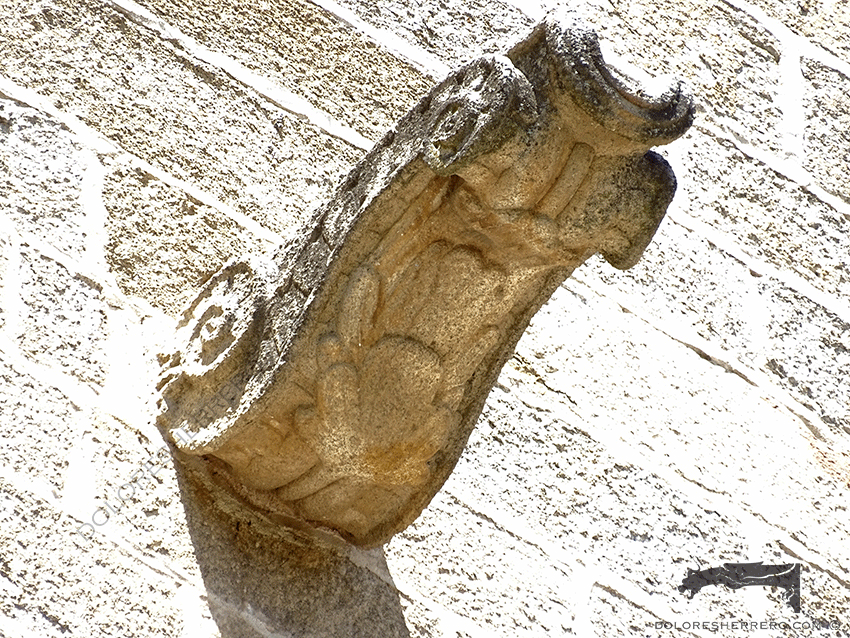
Coria Cathedral (Cáceres, Spain)
There are also simple, schematic gargoyles that may be rectangular, quadrangular, cylindrical or polygonal in shape and serve purely as water spouts. Some of them are decorated with various kinds of mouldings.
- Salamanca Cathedral (Spain)
- Batalha Monastery (Portugal)
- Ávila Cathedral (Spain)
- Zamora Cathedral (Spain)
- Batalha Monastery (Portugal)
- León Cathedral (Spain)
- Astorga Cathedral (Spain)
- Ciudad Rodrigo Cathedral (Spain)
- Zamora Cathedral (Spain)
- Palencia Cathedral (Spain)
- Salamanca Cathedral (Spain)
- Astorga Cathedral (Spain)
- Zamora Cathedral (Spain)
- El Burgo de Osma Cathedral (Spain)
- Cathedral of St. Maurice in Mirepoix (France)
- Astorga Cathedral (Spain)
- León Cathedral (Spain)
- Astorga Cathedral (Spain)
- Ávila Cathedral (Spain)
- Valencia Cathedral (Spain)
Finally, some unusual gargoyles represent a variety of objects, such as vessels, columns and cannons.
Although they do not have the same aesthetic appeal or inspire the same awe as gargoyles representing creatures, many of them remain exceptional pieces, decorated with care, skill and imagination. These gargoyles deserve a small tribute as objects that, in addition to their usefulness, form part of the architecture and decoration of buildings.
- Burgos Cathedral (Spain)
- Santiago de Compostela Cathedral (Spain)
- Batalha Monastery (Portugal)
- Ciudad Rodrigo Cathedral (Spain)
- Burgos Cathedral (Spain)
- Notre-Dame des Doms Cathedral (Avignon, France)
Bibliography consulted
BIEDERMANN, H., Diccionario de símbolos, Barcelona, Ediciones Paidós Ibérica, S. A., 1993.
CHEVALIER, J. y GHEERBRANT, A., Diccionario de los símbolos, Barcelona, Editorial Herder, S. A., 1991.
FORSSMAN, E., Dórico, jónico, corintio en la arquitectura del Renacimiento, Madrid, Xarait Ediciones, 1983.
GOMBRICH, E. H., El sentido del orden. Estudio sobre la psicología de las artes decorativas, Madrid, Editorial Debate, S. A., 1999.
HALL, J., Diccionario de temas y símbolos artísticos, Madrid, Alianza Editorial, S. A., 1987.
PIRIZ PÉREZ, E., La arquitectura gótica en la diócesis de Ciudad Rodrigo, Salamanca, Centro de Estudios Salmantinos. Patronato “José M.ª Quadrado”. Consejo Superior de Investigaciones Científicas, 1974.
QUIÑONES COSTA, A. M., La decoración Vegetal en el Arte Español de la Alta Edad media: su simbolismo, Tesis dirigida por F. Olaguer-Feliú, Facultad de Geografía e Historia. Universidad Complutense de Madrid, 1992.

Doctor of Art History and researcher specializing in the study of gargoyles.
I am Dolores Herrero Ferrio, and my thesis, “An Approach to the Study of Gargoyles of Gothic Cathedrals in Castilla and León”, is dedicated to the study of these fascinating figures.
If you like gargoyles and art history, you will also enjoy my book, “The Gargoyle and Its Iconography,” a book I have written with great care for those interested in the world of gargoyles.
I have created my own Encyclopedia of Gargoyles, a Gargopedia to share with you, where you will discover all the secrets and wonders of these enigmatic sculptures.
I hope you enjoy this Gargopedia as much as I have enjoyed creating it, and remember that each gargoyle has a story to tell, and here you will discover them all.
